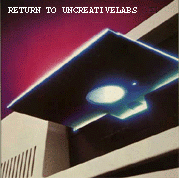| Author |
Message |
Davy Crockett
Joined: 05 Aug 2008
Posts: 23

|
 Posted:
Sun Nov 02, 2008 8:41 pm Posted:
Sun Nov 02, 2008 8:41 pm |
  |
Hi guys,
Been a few weeks since I have checked the boards here.
It's been raining cats and dogs on the west coast, so I have been playing with an old IBM PC/AT that I have upgraded with an Inboard 386/AT. As far as DOS is concerned, it is a 386DX/16 with 12MB of memory. I have a piggyback board on the Inboard that holds 3MB, plus 1MB on the Inboard itself, and 8MB in SIMMS on a 16-bit expansion card. I threw in an old Quantum 420MB SCSI drive on an Adaptec 1542B and an S3 SVGA accelerator with 2MB.
All DOS programs that require a 386+ run flawlessly, and Windows 95 will even run on this system if I hack the autoexec.bat to load the drivers for the Inboard (since it boots as a 286).
My problem is that I have tried to instal OS/2 2.11, and it stops with an error message to the effect that OS/2 requires a 32-bit processor. I take it this is because in a DOS/Windows environment, the autoexec loads up the drivers from Intel that "activate" the 386, whereas OS/2 takes over right after POST and is seeing a 286 BIOS.
Anyone know a creative way around this? |
|
|
  |
 |
wdegroot
Joined: 03 Feb 2006
Posts: 488
Location: pennsylvanai

|
 Posted:
Sun Nov 02, 2008 10:10 pm Posted:
Sun Nov 02, 2008 10:10 pm |
  |
if it is a 386 sx it is close to a 286 rather than a 386,
do you have the capability to put in a real 396?
or could you replace the bios with a award or phoenix bios?.
history"
my first 286 was a vsli,. it had avery nice bios with auto interleave test and type 47 and diaga and a lot of features. I burned a copy and put it in a clone of the ibm at ( not an actual at)
later at intel I had a ibm at fixed and they put in an aftermarket bios. ( they didn;t have an ibm bios)
this leads me to believe that the award and phonex bios' will work in a genuine ibm at. |
|
|
   |
 |
Anonymous Coward

Joined: 20 Nov 2004
Posts: 589
Location: Shandong, China

|
 Posted:
Mon Nov 03, 2008 3:39 pm Posted:
Mon Nov 03, 2008 3:39 pm |
  |
OS/2 2.x should run just fine on a 386SX processor. I'm pretty sure that your inboard has a 386DX though. I think the likely answer to your problem is that the 386 on your inboard is marked "16-bit software only", at least this is the case with the XT inboards.
Try replacing the CPU with a different one and see what happens. The TI486SXL is a good choice since it has optional clock doubling and 8kb cache, but may not work with your current FPU with those features enabled. |
|
|
   |
 |
ryan

Joined: 19 Apr 2006
Posts: 261
Location: WisConSin

|
 Posted:
Tue Nov 04, 2008 1:14 am Posted:
Tue Nov 04, 2008 1:14 am |
  |
Windows wouldn't run on any flavor of Inboard 386/xt without a special upgrade because of the 8bit PC bus.
My assumption is OS/2 is expecting a 16bit or better bus and is seeing an 8bit bus instead and skips installation.
You would need a custom written installation for OS/2 to get around the issue, I know Intel made a Windows 3.0 setup for the inboard 386 but I do not believe they did so with OS/2 |
|
|
   |
 |
Anonymous Coward

Joined: 20 Nov 2004
Posts: 589
Location: Shandong, China

|
 Posted:
Tue Nov 04, 2008 3:20 am Posted:
Tue Nov 04, 2008 3:20 am |
  |
I agree with you there, but Davy Crockett is running an Inboard PC/AT in a 5170 system. This card uses a 16-bit edge connector. |
|
|
   |
 |
ryan

Joined: 19 Apr 2006
Posts: 261
Location: WisConSin

|
 Posted:
Wed Nov 05, 2008 10:31 pm Posted:
Wed Nov 05, 2008 10:31 pm |
  |
| Anonymous Coward wrote: |
| I agree with you there, but Davy Crockett is running an Inboard PC/AT in a 5170 system. This card uses a 16-bit edge connector. |
Blast, a brain fart.
Then the only possibility is a non-sigma 16bit only 386. He should try to install windows 3.1 and see what it does.
If windows won't work then OS/2 won't either. |
|
|
   |
 |
Anonymous Coward

Joined: 20 Nov 2004
Posts: 589
Location: Shandong, China

|
 Posted:
Thu Nov 06, 2008 2:32 am Posted:
Thu Nov 06, 2008 2:32 am |
  |
I think a 16-bit only 386 is likely. It seems to me that Intel really screwed up with the early 386 chips, and rather than scrap them and take a loss decided to dump them onto Inboard users. It's a real knife in the back considering how expensive those things were. I guess for the Inboard PC the decision was okay, but if they did that on the AT version then that is definitely not good. |
|
|
   |
 |
Davy Crockett
Joined: 05 Aug 2008
Posts: 23

|
 Posted:
Fri Nov 07, 2008 6:12 pm Posted:
Fri Nov 07, 2008 6:12 pm |
  |
Well, it wasn't the CPU.
I replaced the IBM BIOS on the mobo with an AMI BIOS from a dead board in my parts stash and now all is well. The date on the "new" BIOS is March 1990. The old BIOS did not show a date when it POST'ed, but the board is marked "'86." The new BIOS also shows the little graph after the POST screen and correctly identifies the CPU as an 80386.
Thanks guys! |
|
|
  |
 |
wdegroot
Joined: 03 Feb 2006
Posts: 488
Location: pennsylvanai

|
 Posted:
Sat Nov 08, 2008 2:49 am Posted:
Sat Nov 08, 2008 2:49 am |
  |
ryan said it better, but the fact that the pc has a 8 bit bus
and a special version or patch to windows was required to run windows with an inboard.
on a similar note:
I was written that the ibm xt bios supported a 720k drive but the earlies AT did not.
neither one would support a 1.44 floppy
but the xt would see it as a 360k or 720k
and native dos would format the diak as a 720k |
|
|
   |
 |
Davy Crockett
Joined: 05 Aug 2008
Posts: 23

|
 Posted:
Sat Nov 08, 2008 3:20 am Posted:
Sat Nov 08, 2008 3:20 am |
  |
Wdegroot,
My understanding is that a floppy controller with a newer BIOS will allow one to run high-density 3 1/2" floppy drives in an old XT or 286 system. I had a 2.88MB drive in a 286 at one time, and I have seen at least a few XT clones with 1.44MB drives. All of these machines had aftermarket controllers. I've also seen "large" (over 540MB) IDE hard drives in 286's, again with a newer controller. |
|
|
  |
 |
Anonymous Coward

Joined: 20 Nov 2004
Posts: 589
Location: Shandong, China

|
 Posted:
Sat Nov 08, 2008 6:35 am Posted:
Sat Nov 08, 2008 6:35 am |
  |
The high density floppy controller with BIOS isn't 100% necessary in either configuration. The original ATs that lacked support for the 1.44meg drive just needed the driver.sys file to support the drive. As I've said many times before, for the XT use 2M V3 to emulate the AT BIOS and a 16-bit multi I/O for the hardware support.
You should still really look into your CPU if you haven't already to make sure that the double sigma isi there. If the card is from '86, chances are it has one of the buggy CPUs. Not all of the 16-bit only 386s were marked as such, so I'd keep an eye out for that double sigma. |
|
|
   |
 |
|
|
